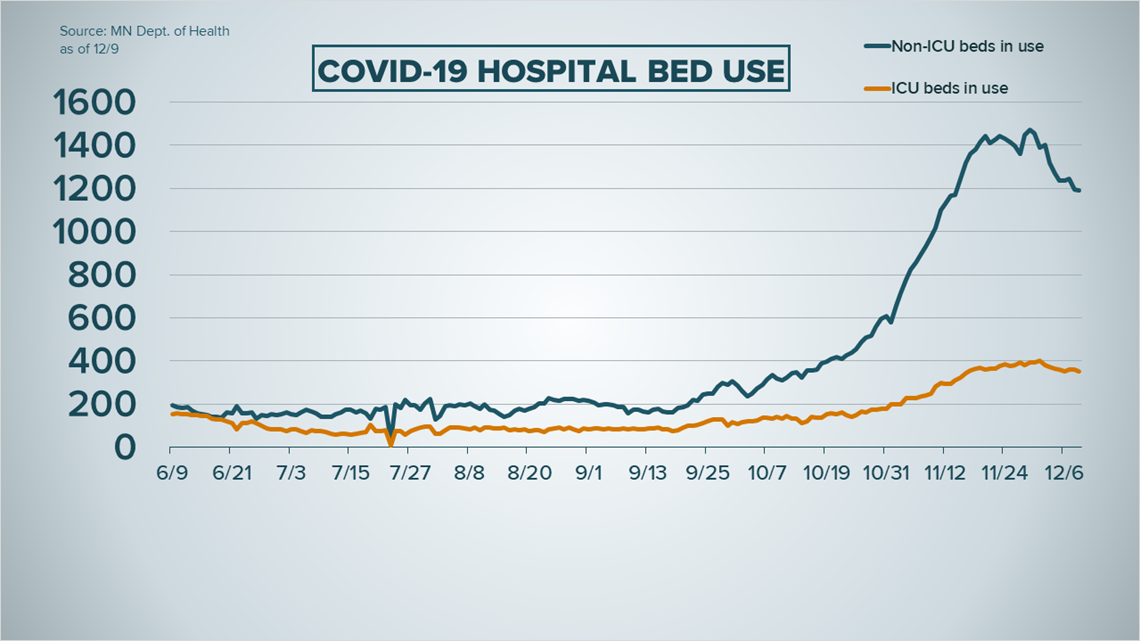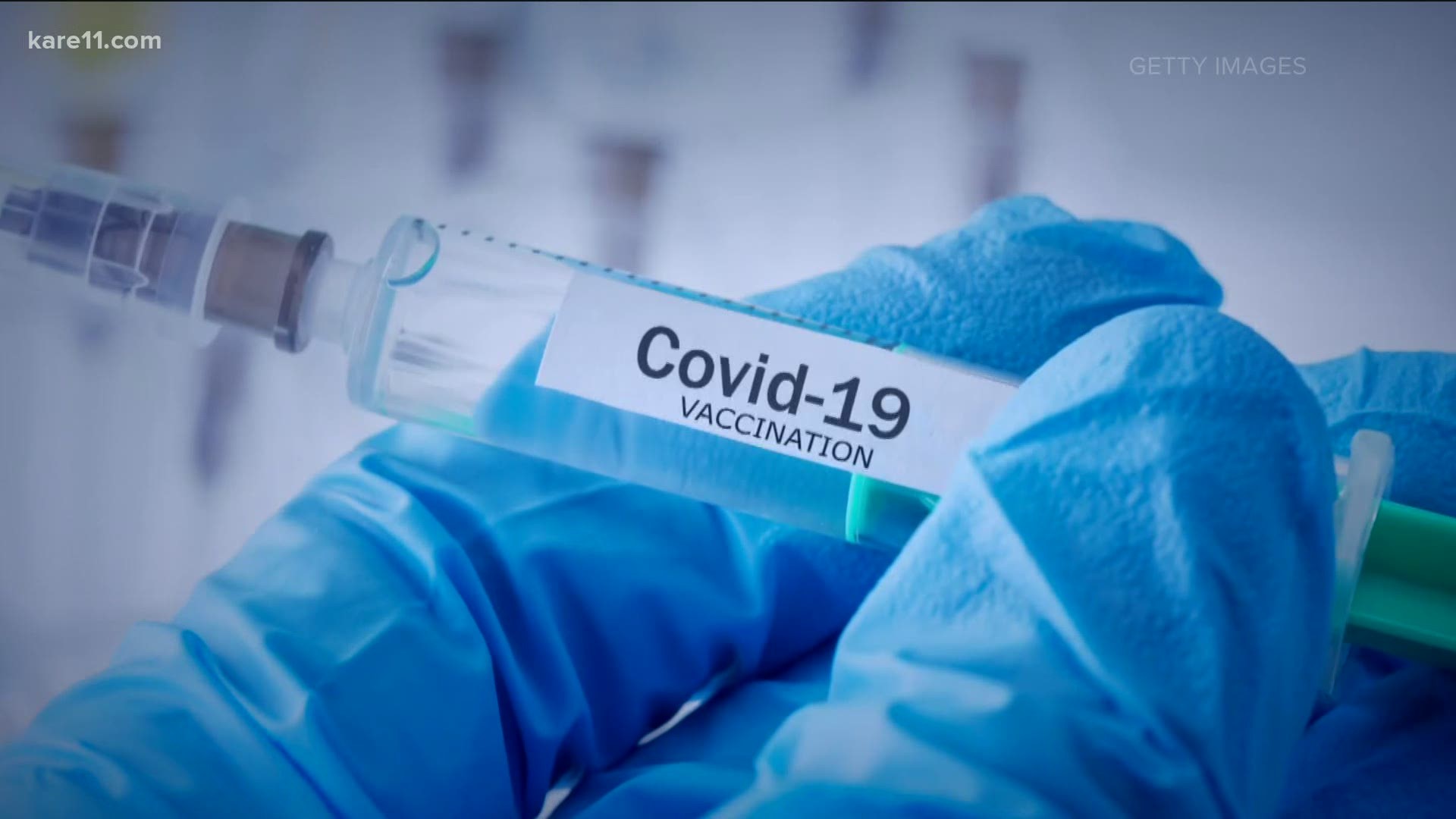ST PAUL, Minn. — Listen live: Minnesota health officials discuss COVID-19 spread in the state, long-term effects of the virus.
Thursday, Dec. 10
- 1 patient between ages 20-24, another 25 to 29 have died of COVID
- Walz to announce decision on "pause" Monday
- COVID-19 vaccine to be free of cost
- Minnesota is expecting to receive 183,000 COVID-19 vaccines over the next month
- People will need to receive two doses of the vaccine
2 p.m.
The Minnesota Department of Health (MDH) held a briefing call Thursday at 2 p.m. to give the public an update on COVID-19 spread across the state.
MDH Commissioner Jan Malcolm shared the latest updates on COVID-19 cases in Minnesota, including the third-highest death count so far in the pandemic on Thursday.
MDH Medical Director Dr. Ruth Lynfield joined Thursday's call to share information about the long-term health effects of the coronavirus.
"Many people who are infected with COVID-19 do not have symptoms," she said. "And therefore some do not know they have it unless they get tested. This is estimated that about 50% of transmission can occur in people who are pre-symptomatic or asymptomatic."
Lynfield said that those who are asymptomatic can spread the virus to people who then develop severe cases. But even those with mild cases can get long-term symptoms. These cases are often referred to as "long-haulers."
"In some cases COVID-19 is not just an acute illness," Lynfield said.
Some people who were hospitalized, and even those who had a mild case, are seeing long-term effects from the virus, Lynfield said.
"They can develop symptoms that can go on for weeks or months," Lynfield said.
Experts are still trying to figure out how common these are, and who is most likely to get them.
The symptoms include:
- Shortness of breath
- Cough
- Joint pain
- Chest pain
- Difficulty in thinking and concentration, often called "brain fog"
- Memory difficulties
- Change in mood
- Anxiety
- Muscle pain
- Headaches
- Fever
- Heart palpitations
"We are also seeing psychiatric complications in association with COVID," Lynfield said. "I mean there really is a wide variety of complications."
Lynfield said the medical and public health communities are trying to come up with language and definitions around "long-haulers." She said she does not know how many Minnesotans fall into this category.
"I have seen large percentages that vary in the medical literature," she said of the national numbers. "I'm a little hesitant to guesstimate."
More than 15,000 cases of COVID-19 have been reported in Minnesota children. Lynfield reminded families that children who are diagnosed with COVID-19 can be at risk of a syndrome called MIS-C. While it's rare, she said, it often lands children in the ICU.
"We don't know everything that we want to about MISC, but we do know that if we can limit the spread of COVID-19, then we can limit this from occurring," Lynfield said.
A similar syndrome has been seen in young adults, called MISA. At least 70 cases have been reported nationally, and two of them have been in Minnesota.
Two people in their 20s were among the COVID-19 deaths reported on Thursday.
"We are seeing increasing numbers in those younger age groups," Malcolm said.
The younger people who are dying from COVID-19 often have underlying conditions, Lynfield said, but she emphasized that MDH is concerned that those deaths in young people are going up.
"Generally the younger people have a variety of health conditions," Lynfield said. "We do see that obesity as well as diabetes and hypertension come up a fair amount. But we all need to remember that these conditions are very common in our communities and so it truly is of great concern ... that we are starting to see deaths in younger individuals."
11 a.m.
The deadly impact of COVID-19 continues to be felt across Minnesota, with another near-record of fatalities reported Thursday by the Minnesota Department of Health (MDH).
State health officials say 89 coronavirus deaths were recorded in the past day, now the third-highest single-day total since the start of the pandemic. Two young adults between the ages of 20 and 29 are among those deaths. The total number of people who have perished has risen to 4,198. Of that number 2,767, or 66% of the deaths are linked to assisted living or long-term care facilities.


MDH recorded 3,523 new COVID-19 cases in the past 24 hours, based on 41,499 tests (38,280 PCR, 3,219 antigen) processed in private and state labs. A positive PCR test is considered a confirmed case, while a positive antigen test is regarded as a probable case.
In all, 367,218 COVID-19 cases have been recorded in Minnesota since the pandemic began. Of those cases, 9,409 were based on antigen tests.
Of the people who at one time tested positive for the virus, 324,304 have recovered to the point they no longer require isolation.
Currently COVID patients occupy 1,542 of Minnesota's hospital beds, with 352 of those in the ICU. Non-ICU bed availability remains low in the Twin Cities metro, with 118 beds, or 3.2% of total capacity available. That is up slightly from Wednesday. ICU beds are not as low, with 39 available (5.7%).


The largest segment of Minnesota's coronavirus cases involve young adults, with 20 to 24-year-olds accounting for 38,223 cases and three deaths, with one passing in the last day. Those 25 to 29 make up 33,155 cases and five deaths, one more than on Wednesday.
Minnesota's largest grouping of fatalities involves people 85 to 89, with 791 deaths in just 4,760 diagnosed cases.
Hennepin County reports the most COVID activity in the state with 76,902 cases and 1,200 deaths, followed by Ramsey County with 32,625 cases and 566 fatalities, Dakota County with 26,208 and 224 fatalities, and Anoka County with 25,815 cases and 250 deaths.
Cook County in northeastern Minnesota has recorded the least COVID activity with 93 cases and zero fatalities. It is the only county still in double-digits for cases of the virus.
Full distance learning is now recommended in all of Minnesota's 87 counties, based on a weekly report of county-level COVID-19 rates.
2 p.m.
MDH Commissioner Jan Malcolm said the best thing Minnesotans can do to end the pandemic is to get the vaccine when it is available. Malcolm added that the vaccine is not mandated but getting vaccinated will be encouraged.
The FDA is expected to send guidelines for vaccinations for people with underlying health conditions.
The federal government will cover the cost of the vaccine. It will be free of cost but if you have insurance you will still be asked to show it, Malcolm said.
Clinics may still charge a visit or administration fee, which insurers can cover, Malcolm explained.
11 a.m.
Both reported deaths and new COVID-19 cases jumped in the past day, according to numbers released Wednesday by the Minnesota Department of Health (MDH).
An additional 82 people have died from the virus, bringing total fatalities since the beginning of the pandemic to 4,109. Of those deaths 2,711, or 66% of them are associated with long-term care or assisted living settings.
The 82 deaths are the third-highest single day total reported. Health officials reported 101 deaths Nov. 27, and 92 on Dec. 3.
MDH says 4,539 new cases of coronavirus were registered in the last 24-hour reporting period based on 39,591 tests (34,863 PCR, 4,728 Antigen) processed in private and state labs.
Health officials say a positive PCR test is considered a confirmed case, while a positive Antigen test is listed as a probable case.
In total, 363,719 positive cases have been recorded since the onset of COVID-19. Of those cases 9,129 are based on antigen tests.
KARE 11’s coverage of the coronavirus is rooted in Facts, not Fear. Visit kare11.com/coronavirus for comprehensive coverage, find out what you need to know about the Midwest specifically, learn more about the symptoms, and see what businesses are open as the state slowly lifts restrictions. Have a question? Text it to us at 763-797-7215. And get the latest coronavirus updates sent right to your inbox every morning. Subscribe to the KARE 11 Sunrise newsletter here. Help local families in need: www.kare11.com/give11.
The state of Minnesota has set up a data portal online at mn.gov/covid19.

